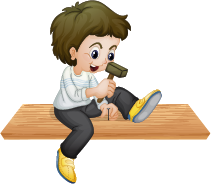Y1. Lesson 9. Rhythm
Prior learning: Beat
Duration: 30 minutes
Materials: Woodblocks or claves
Keywords: Beat, rhythm, singing, chanting, partners, rhymes, circle games.
Difficulty: ![]()
Prepare
ta & ti-ti
Present
Rhythm
Practise
High & low sounds, beat
 Melodic development
Melodic development
![]() Students discover a new song and investigate how many sounds are on the beat.
Students discover a new song and investigate how many sounds are on the beat.
- Students are seated and attentive.
- Explain that musicians use a word for how the words go in a song, called rhythm. Write the word on the board. Students are not expected to be able to spell the word.
- Tell the class they will learn the song Rain Rain.
- Use a neutral syllable to establish the melody, then sing the lyrics line-by-line the next time.
- Ask students to follow you as you sing again in a measured cadence.
- Ask students to keep the beat on their knees as they sing.
- Monitor students to establish in-tune singing and clear voices.
- When secure, ask the class to clap the rhythm as they sing again.
 Questions
Questions
- What is the word musicians use for the ways the words go in music?
- When you clapped the beat, did some beats have more than one sound?
- How many sounds do the words "Rain, rain" have?
- Clap the words "go away". How many sounds were there?
 Rhythmic development
Rhythmic development
![]() Students use gross locomotor movements and imaginative play in this song.
Students use gross locomotor movements and imaginative play in this song.
- Students stand in a circle. Lead the class by singing the song and demonstrating the body movements.
- When Johnny works with one hammer, students tap one fist on their legs.
- When Johnny works with two hammers, students tap both fists on their legs.
- When Johnny works with three hammers, students tap both fists on their legs and tap one foot on the floor.
- When Johnny works with four hammers, students tap both fists on their legs and tap both feet on the floor.
- When Johnny works with five hammers, students tap both fists on their legs, tap both feet on the floor, and nod their heads down and up.
- At the end of the song, children rest their heads on their hands and pretend to go to sleep.

 Questions
Questions
- How many hammers did Johnny begin with?
- How many hammers did he use at the end of the song?
- Do you think someone could really work with more than one hammer?
 Creative movement
Creative movement
![]() Students have fun in this circle game while keeping the beat on their laps.
Students have fun in this circle game while keeping the beat on their laps.
- Students are in a circle, either standing or sitting.
- A chosen student stands outside the circle holding a prop, such as a purse or small bag.
- The student skips around the circle as the class sings the song and claps the beat.
- At the song's end, the student immediately drops the pocket.
- The student standing in front of the pocket chases the other student around the circle back to their starting position.
- The student who reaches the empty position first is the winner.
- The game is repeated as time permits.

 Listening
Listening
![]() Students clap the rhythm of a familiar piece of art music.
Students clap the rhythm of a familiar piece of art music.
 Questions
Questions
- What is the surprise in the music?
- What the composer of this music was called?
- Which country did he come from?
- What did the music make you wonder?
- Explain to students that they will hear a piece of music composed by a composer in a country called Austria a long time ago. It has a surprise at the end.
- Play the excerpt of the music on the audio player.
- Ask students first to clap the beat.
- Play the music again. This time, students should clap the rhythm.
 Visual learning
Visual learning
![]() Students use visual icons to differentiate between beat and rhythm.
Students use visual icons to differentiate between beat and rhythm.
- Students are seated.
- Lead the class in singing Snail, Snail and ask them to clap the beat.
- When secure, tell the class they will sing again, but this time clapping the rhythm.
- Project the beat sheet [full toggle screen], or hand out worksheets with the Snail, Snail beat chart and ask students to point to the beats as they sing the song.
- Next, use the rhythm chart for the song and ask students to point to the words as they sing.
- Ask a volunteer to come forward and point to the snails in the rhythm sheet as the class sings.
- Repeat with other students.
- Discuss with the class the difference between beat and rhythm.
 Instruments
Instruments
![]() Students discover the xylophone, a tuned percussion instrument.
Students discover the xylophone, a tuned percussion instrument.
- Divide the class into two groups. One group will use xylophones to play the melody of Goodnight, and the other will sing and use body percussion to demonstrate high and low sounds
- Assign two students per xylophone.
- Explain to the class that they will sing, use movement and play the song Goodnight.
- One student will play the notes, and the other will face the player and point to the correct bars. After each repetition, they will swap.
- Lead the class by singing the song. One-half of the class will sing and put the high sounds on their heads and the low sounds on their shoulders.
- Swap the two groups so that every child has a turn in playing the xylophone.
![]() Label each instrument numerically for easy distribution to students (i.e. Susan collects xylophone 1, etc.) Show the xylophone players how to lightly pinch the mallets between their thumb and pointer fingers, then wrap the rest of their fingers around the mallet. Then demonstrate how to play the two notes of the melody.
Label each instrument numerically for easy distribution to students (i.e. Susan collects xylophone 1, etc.) Show the xylophone players how to lightly pinch the mallets between their thumb and pointer fingers, then wrap the rest of their fingers around the mallet. Then demonstrate how to play the two notes of the melody.
 Part work
Part work
![]() Students copy the teacher's rhythm patterns at the end of this rhyme.
Students copy the teacher's rhythm patterns at the end of this rhyme.
![]()
This video shows Dr James Cuskelly teaching the rhyme to prep students. This rhyme also works well for first year students.
I had a little pig,
And I fed him in a trough.
He got so fat,
That his tail popped off!
I got me a hammer,
And I got me a nail,
And I made my pig
A brand-new tail.
- Present the rhyme to the class, maintaining a measured cadence while performing the puppet play according to the video.
- This activity allows students to understand rhythm as "the way the words go".
- This captivating rhyme serves not only as entertainment but also as an effective rhythm exercise for students.
- Employ a pig puppet to recite the rhyme, allowing it to "speak" while encouraging the class to participate in unison. This interactive approach fosters engagement and reinforces rhythm learning.
- Upon completing the rhyme, introduce a simple rhythm pattern by striking the sticks together. Instruct students to mimic this pattern by tapping their knees, ensuring they copy the rhythm.
- Next, select a student to come to the front of the class and provide them with sticks. Prompt them to reproduce the rhythm pattern, allowing them to demonstrate their understanding of the rhythm.
- Repeat this process, incorporating a new rhythm pattern for the class. Involve another student in the exercise, allowing them to showcase their ability to adapt to different rhythm patterns.
- By iterating this procedure, students gain exposure to various rhythm patterns, promoting active participation and enhancing their rhythmic skills.
 Assess
Assess
Suggested lessons
Y1. Beat II

Y1. Beat III

Y1. Beat IV

